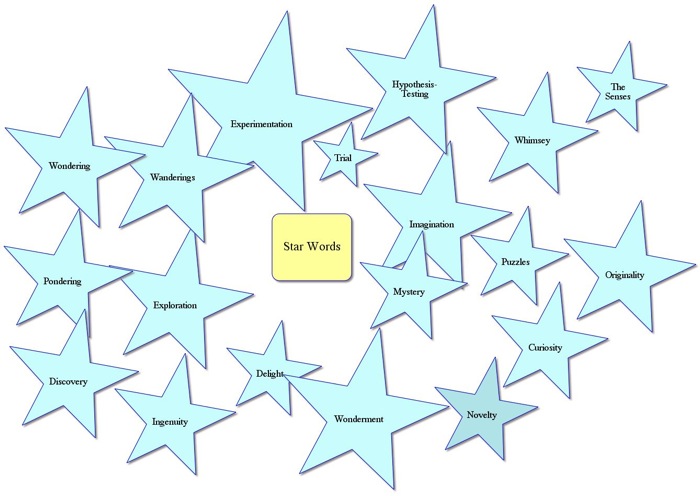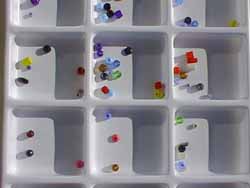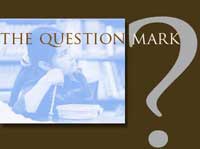The Early Childhood Workshop
By Jamie McKenzie
About Author
 In May of 2008 I met with some 70 or more early childhood teachers from the region surrounding Tauranga in New Zealand to explore ways that kindergarten and very young children can develop their thinking, questioning and imagining skills. We spent the day together exploring a cluster of words we called "star words" as they related to dreaming and imagination. In May of 2008 I met with some 70 or more early childhood teachers from the region surrounding Tauranga in New Zealand to explore ways that kindergarten and very young children can develop their thinking, questioning and imagining skills. We spent the day together exploring a cluster of words we called "star words" as they related to dreaming and imagination.
New Zealand has an exemplary curriculum for the young ones as outlined on the Ministry Web site, Te Whariki - Early Childhood Education .
Early in the day we enjoyed a painting of the Milky Way by aboriginal artist Malcolm Jagamarra.
Painting
“Desert art has given everyone a chance to learn about Aboriginal Dreaming,” says Jagamarra. “Our art reflects not just the land but its mythology, song and dance.”
Each participant kept a personal constellation of star words in a journal as the day proceeded. Entries might include some or all of the following:

Session One - Curiosity, Wonderment, Puzzles, Mystery and Delight
During this session, we explored the meanings of curiosity, wonderment, puzzles, mystery and delight. Everyone wrote down what they thought was meant by "a sense of wonder." The group looked at seven photographs of children and considered which showed the most wonder or wonderment.

The group also opened boxes of jigsaw pieces and "made the most" of their pieces without actually putting together the original puzzle.
"Making up your mind" - an activity with jigsaw puzzles
Session Two - Ingenuity, Novelty, Imagination and Originality
During this session we focussed on synthesis and explored the meanings of ingenuity, novelty, imagination and originality.
"What color is the sky?" - The group worked in teams to paint skies that were dramatic and vibrant. You can enlarge the pictures below by clicking on them.
We moved on to synthesis with song using "The Second Story Window" as away to change the words of nursery rhymes. All children are songwriters at heart. They make up songs in the tub, the sand box and the bed, improvising, inventing and crooning with plenty of confidence. Wouldn't it be nice to encourage a life time of such invention?
Session Three - Discovery, Exploration, Pondering, Wondering, Wandering
"Making friends" - an activity with the story, "The Lost Button" from the collection, "Frog and Toad are Friends." We stop the story after Toad has thrown several tantrums and ask the young ones what choices they have if a friend acts this way.
- "I would get a new friend."
- "I'd give him a time out!"
- "I'd punch him."
- "I'd go home and let him find his own button."
- "I'd tell him to stop screaming."
Next we role play each of these choices so the four year olds can compare and contrast them, noting the consequences for each. Role-playing for social decision-making has been used for decades with young children to help them consider the consequences likely to accompany various choices.
"Making Do" - an activity with Play-doh. Some tables make arms. Some make legs. Some make torsos. Others make heads. Then the arms, legs and heads "walk about" to find torsos. More synthesis.
Session Four - Experimentation, Trial, Hypothesis-Testing and Whimsey
"Reaching for the sky" - an activity with blocks. So often young ones try to build "So big!" During this activity the teachers identified 6-8 other design strategies that might guide block building and translated those strategies into the structures below. You can enlarge the pictures below by clicking on them.
Session Five - Awakening all of the senses
"The bead tray" - an activity with flowers. Each person has a flower and a sheet of paper to employ like a bead tray, with a box for words to match the six senses evoked by the flower: smell, sight, sound, taste, touch and magic.

"Biscuit A and Biscuit B" - an activity with biscuits. Building on the six senses used to consider the flower above, each person has two cookies, Biscuit A and Biscuit B. Drawing two columns on a sheet of paper with Biscuit A and Biscuit B at the top, each person comments on the smell, sight, sound, taste, touch and magic of each cookie.
Session Six - Synthesis
Considering and pondering on the day's insights and discoveries.
The day finished with discussion and journal writing.
- A new word each day keeps the ____________ away.
-
- What were the five most important new insights you picked up today?
- What are your 3 most favorite star words?
- What is an activity you might try with your young ones inspired by today?
|

 In May of 2008 I met with some 70 or more early childhood teachers from the region surrounding Tauranga in New Zealand to explore ways that kindergarten and very young children can develop their thinking, questioning and imagining skills. We spent the day together exploring a cluster of words we called "star words" as they related to dreaming and imagination.
In May of 2008 I met with some 70 or more early childhood teachers from the region surrounding Tauranga in New Zealand to explore ways that kindergarten and very young children can develop their thinking, questioning and imagining skills. We spent the day together exploring a cluster of words we called "star words" as they related to dreaming and imagination. 



































